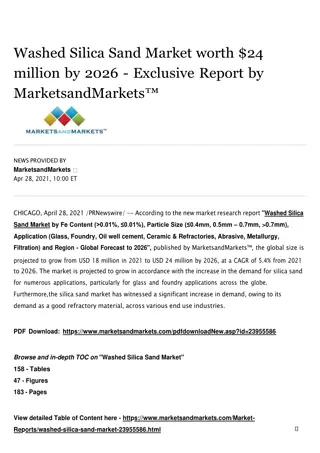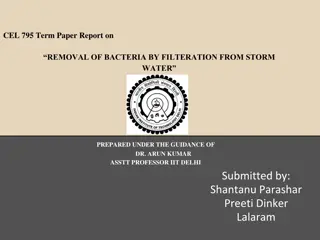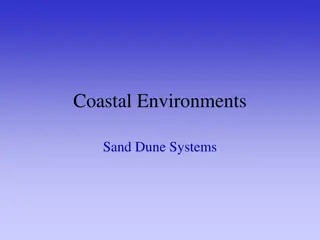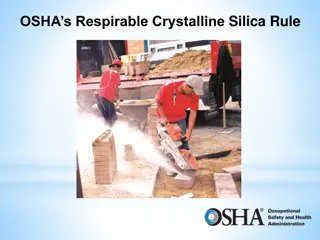Respirable Crystalline Silica
Respirable Crystalline Silica, found in various materials like concrete and sandstone, poses serious health risks when inhaled. Exposure can lead to silicosis, lung cancer, kidney disease, and other respiratory issues. This hazardous substance primarily affects workers in construction and general in
0 views • 66 slides
Sand-Lime Bricks: Advantages, Disadvantages & Applications
Sand-lime bricks, made from sand and lime, offer numerous advantages in masonry construction, including uniformity, strength, fire resistance, and reduced construction costs. However, they also have limitations such as poor abrasion resistance. Discover the uses, characteristics, and differences of
6 views • 9 slides
Washed Silica Sand Market: Growth, Trends, and Opportunities
The market is projected to grow in accordance with the increase in the demand for silica sand for numerous applications, particularly for glass and foundry application across the globe. Furthermore, the silica sand market has witnessed a significant increase in demand, owing to its demand as a good
3 views • 4 slides
Understanding Sand Dune Vegetation: Citizen Science Survey
Conduct a vegetation survey to track changes in sand dune ecosystems over time. Monitor bare sand cover, vegetation types, plant species health indicators, and nutrient levels. Learn how to conduct the survey to help inform management decisions and preserve dune environments effectively.
0 views • 10 slides
Overview of Cement: Types, Composition, and Functions
Cement is a vital building material consisting of various compounds like lime, silica, and alumina. It is used in mortar and concrete. The chemical composition of cement includes elements like iron oxide and gypsum. Different types of cement serve specific purposes such as rapid hardening or sulfate
0 views • 29 slides
Workplace Exposure Standard for Silica Dust in Stone Benchtop Fabrication
Reduction in workplace exposure standard for respirable crystalline silica dust has been implemented, halving the national standard to 0.05 mg/m3. The new standard aims to protect workers in stone benchtop fabrication businesses from serious lung diseases caused by breathing in silica dust. Employer
1 views • 8 slides
Geomechanical Effects of Oilfield Chemicals on Sand Failure in Reservoir Rocks
This study by Elizabeth O. Wuyep et al. explores the geomechanical effects of oilfield chemicals on sand failure in reservoir rocks. It discusses the role of oilfield chemicals, limitations of previous works, experimental flow chart, and static saturation tests. The research emphasizes the need for
0 views • 25 slides
Controlling Silica Hazards: Effective Engineering Controls
Techniques for controlling silica hazards in the workplace include elimination, substitution, and engineering controls like ventilation, dust containment systems, wet methods, and housekeeping practices. Elimination involves removing silica exposure risks, while substitution replaces risky materials
1 views • 21 slides
Understanding Filtration Mechanisms for Water Treatment
Filtration is a crucial process in water treatment where granular media remove solids through mechanisms like straining, sedimentation, impaction, and interception. Different types of filters, such as slow sand filters, rapid sand filters, and pressure filters, play vital roles in ensuring water qua
3 views • 10 slides
Understanding Filtration Mechanisms in Water Treatment
The filtration mechanism in water treatment involves various processes such as straining, sedimentation, impaction, and interception. Different types of filters like slow sand filters, rapid sand filters, and pressure filters play a crucial role in removing solids from water. Monitoring filtration i
1 views • 16 slides
Maximizing Bacteria Removal from Storm Water through Filteration Research
This term paper report focuses on the removal of bacteria from storm water using different filteration methods. The study reviews research on sand media filters and explores the efficiency of bio sand filters in removing pathogens such as E. coli, Cryptosporidium, and Salmonella. Key findings highli
7 views • 8 slides
Neutrino Interactions with Liquid Argon at DUNE Near Detector Complex
The Deep Underground Neutrino Experiment (DUNE) aims to study neutrino oscillations using high-precision measurements with detectors like the Near Detector complex located downstream of the neutrino beam. Components such as ND-LAr and SAND play crucial roles in scanning energy spectra. SAND, a perma
0 views • 16 slides
Understanding Sand Crack in Cattle Hooves: Causes, Signs, and Treatment
Sand crack, a fissure of the horny wall in cattle hooves, can present transversely or longitudinally. It commonly affects dairy breeds and is predisposed by various factors such as overgrowth of digital horn and chronic laminitis. Diagnosis and treatment differ based on the form of the crack, with s
0 views • 10 slides
Understanding the Health Effects of Silica Exposure
Silica exposure poses serious health risks as respirable crystalline silica particles can penetrate the body's natural defenses, leading to conditions like silicosis, tuberculosis, lung cancer, and chronic bronchitis. The silica particles that bypass initial defenses can cause inflammation and fibro
0 views • 17 slides
Understanding Market Research for Business Success
Market research is crucial for businesses to gather information about their target market, customer needs, competition, and market trends. Primary and secondary research methods, market share analysis, demand assessment, and calculating market size are key aspects discussed in this content. Various
1 views • 5 slides
Occupational Safety and Health Concerns with Crystalline Silica Exposure
Crystalline silica exposure poses serious health risks, including chronic silicosis, lung cancer, COPD, and kidney diseases. OSHA addresses this issue through programs like NEP, enforcing exposure limits, and requiring safety measures in the construction industry such as respiratory protection and e
0 views • 23 slides
Importance of Respirable Crystalline Silica Awareness in Construction
Understanding the hazards of respirable crystalline silica in construction is crucial for preventing serious health issues among workers. This guidance highlights the risks associated with silica exposure, the new enforcement rules, and the importance of implementing control measures to minimize exp
0 views • 7 slides
Understanding Soil Texture and Its Impact on Rangeland Health
Soil texture, determined by the proportion of sand, silt, and clay, plays a crucial role in rangeland health. It affects pore spaces, water infiltration and percolation, water-holding capacity, aeration, erodibility, and compactability. Different particle sizes influence these soil properties, with
0 views • 4 slides
Strong Objection to Proposed Lea Castle Sand Quarry in Cookley
Gail Blunn, a resident of Cookley, raises issues on environmental, health, mental health, community, historical, and personal grounds against the proposed Lea Castle Sand Quarry. The objections include threats to wildlife, impact on air quality and public health, loss of green spaces vital for menta
0 views • 9 slides
Event Classification in Sand with Deep Learning: DUNE-Italia Collaboration
Alessandro Ruggeri presents the collaboration between DUNE-Italia and Nu@FNAL Bologna group on event classification in sand using deep learning. The project involves applying machine learning to digitized STT data for event classification, with a focus on CNNs and processing workflows to extract pri
0 views • 11 slides
Sustainable Construction of Coastal Facilities with Beach Sand & Brackish Water in Concrete
Explore a sustainable approach to constructing coastal facilities by incorporating beach sand and brackish water in concrete production. This method aims to address environmental concerns, reduce reliance on non-renewable resources like sand, and enhance the durability of structures. The project inv
0 views • 15 slides
GCSE Separation Challenge: Iron, Sulfur, Sand, and Food Dyes Mixture
Students are tasked with separating a mixture containing iron, sulfur, sand, and food dyes using various techniques. They work in pairs, following provided instructions and using specific equipment. Marks are awarded based on successful separation and organization. The challenge involves planning, e
0 views • 8 slides
Understanding Silica Hazards in Construction Materials
Silica is a common hazard in construction materials, with around 2.3 million workers exposed to airborne silica dust. This dust can lead to silicosis and other lung diseases, posing health risks based on exposure levels and duration. Regulations like the permissible exposure limit (PEL) and time-wei
0 views • 11 slides
Understanding Coastal Sand Dune Systems and Formations
Explore the intricate world of coastal sand dune systems, including the accumulation of windblown sediment, sand movement processes, dune formation stages, morphology classifications, and further categorization of dune types such as bay dunes and offshore island dunes. Learn about the vital role of
0 views • 7 slides
Impacts of Sand Mining Industry on Interprovincial State Land Management
The study delves into the impacts of sand mining industry on land management in Mahaweli Riverbank, Mahiyangana, Sri Lanka. It explores the methods of sand mining, uses of sand in various industries, the relationship between sand mining and land management, issues surrounding sand storing land, and
0 views • 19 slides
Gas Processing: Dew Point Control and Refrigeration Systems
Gas processing involves gathering raw gas from wells, passing it through various units like feed gas receiving, condensate stabilization, gas treating, dew point control, and refrigeration units to control liquid condensation and recover natural gas liquids. Dew point control helps prevent condensat
0 views • 26 slides
Understanding BCG Matrix: Market Growth and Relative Market Share
BCG Matrix, developed by Bruce Henderson of the Boston Consulting Group, categorizes business units into Question Marks, Stars, Cash Cows, and Dogs based on market growth and relative market share. Market share and market growth are crucial factors in determining a company's position in the market.
0 views • 31 slides
Difference Between Capital Market and Money Market: A Comprehensive Overview
The capital market and money market serve different purposes in the financial world. While the capital market provides funds for long-term investments in securities like stocks and debentures, the money market deals with short-term borrowing and lending of funds. The capital market acts as a middlem
0 views • 4 slides
Numerical Modeling for Hydraulic Fracture Prediction on Fused Silica Samples
Goal of the project is to predict the overpressures required to fracture fused silica cylindrical samples using numerical modeling. The study focuses on a homogeneous pure material with known mechanical properties compared to experimental results from a lab-scale stimulation system. The model includ
0 views • 7 slides
Environmental Remediation Using Silica/Silicates for Contaminant Oxidation
Utilizing silica and silicates as chemical oxidants in environmental remediation has been approved under the general WDR permit since 2010. With over 1,500 applications in the US and Canada, including 148 in California, these substances are known for their safety and effectiveness in contaminant oxi
0 views • 8 slides
OSHA's Respirable Crystalline Silica Rule Overview
Exposure to respirable crystalline silica can lead to serious health risks including silicosis, lung cancer, COPD, and kidney disease. The rule covers the scope of coverage, permissible exposure limits, exposure assessment methods, and requirements for construction sites. It emphasizes the importanc
0 views • 31 slides
Understanding Aluminium Sand Casting Process
Aluminium sand casting is a cost-effective process commonly used in schools due to its affordability and achievable casting temperature. The process involves pattern making, moulding, pouring molten metal, removing sand, and cleaning the final workpiece. Quality patterns and moulds are crucial for s
0 views • 10 slides
Automated Quantification of 1D NMR Spectra with SAND
SAND is an automated method for quantifying 1D NMR spectra using time-domain modeling by modeling signals as exponentially decaying sinusoids. It uses random subsets of input data for training and validation, combining Markov chain Monte Carlo and fixed-point optimization. SAND determines the number
0 views • 25 slides
Technical Organization for SAND Construction, Installation, and Operation
The Technical Organization for SAND Construction, Installation, and Operation involves various Working Groups responsible for deliverables such as designs, hardware components, software packages, and technical documents. The Consortium Technical and Software/Analysis Boards play key roles in decisio
0 views • 5 slides
Expendable-Mold Casting Processes in Sand Casting: Lecture Insights
Sand casting is a process wherein molten metal is poured into a sand mold, left to solidify, and then the mold is broken to retrieve the casting. This casting method involves pattern making, mold creation, and uses a gating and riser system for complex geometries. Riser design is crucial in managing
0 views • 9 slides
Explore Frac Sand Hauler Opportunities
Dive into the world of frac sand hauling and discover the driver requirements, SafeLand training, H2S training, respiratory fit test certification, and CDL holders' medical card necessities. Join the pack today and embrace the journey into this industry!
0 views • 8 slides
Enhancing Bacteria Removal from Storm Water through Advanced Filtration Methods
In this term paper report, the focus is on maximizing the removal of bacteria, including pathogens like E. coli, from stormwater using sand media filters. The study reviews current research on sand media filters, compares different filter types, analyzes parameters affecting filter performance, and
0 views • 8 slides
Darcy's Law for Flow through Porous Medium and Water Filtration Device
Darcy's Law, first published in 1856, describes water flow through porous mediums, specifically sand layers. The law is applied to develop a new water filtration device for efficiently supplying water to a large city. Experimental demonstrations and tests conducted in 1855 support the relationship b
0 views • 4 slides
Enhancing Concrete Strength and Durability with Silica Fume and Fly Ash
The research explores the use of industrial waste materials like fly ash and silica fume in concrete to improve its strength and durability. By replacing a portion of cement with these materials, the resulting concrete mix becomes stronger, more durable, and eco-friendly. Fly ash and silica fume con
0 views • 12 slides







































